
Myliobatiformes is one of the four orders of batoids, cartilaginous fishes related to sharks. They were formerly included in the order Rajiformes, but more recent phylogenetic studies have shown the myliobatiforms to be a monophyletic group, and its more derived members evolved their highly flattened shapes independently of the skates.

A tunicate is a marine invertebrate animal, a member of the subphylum Tunicata. It is part of the Chordata, a phylum which includes all animals with dorsal nerve cords and notochords. The subphylum was at one time called Urochordata, and the term urochordates is still sometimes used for these animals. They are the only chordates that have lost their myomeric segmentation, with the possible exception of the 'seriation of the gill slits'.

Ascidia is a genus of tunicates in the family Ascidiidae.

Clavelinidae is a family of tunicates in the order Enterogona. It describes a group of marine animals.

Styela clava is a solitary, subtidal ascidian tunicate. It has a variety of common names such as the stalked sea squirt, clubbed tunicate, Asian tunicate, leathery sea squirt, or rough sea squirt. As its common names suggest, S. clava is club-shaped with an elongated oval body and a long peduncle for attaching to a substrate. Although native to the northwestern waters of the Pacific Ocean, since the 1900s, S. clava has become an increasingly successful invasive species outside of its native range. It is edible.

Clavelina is genus of sea squirts, containing the following species:

Phlebobranchia is a suborder of sea squirts in the class Ascidiacea.

Pyura stolonifera, commonly known in South Africa as "red bait", is a sessile ascidian, or sea squirt, that lives in coastal waters attached to rocks or artificial structures. Sea squirts are named for their habit of squirting a stream of water from their exhalant siphons when touched at low tide.

Pyura praeputialis is an intertidal and shallow water species of tunicate. It is one of three species of "cunjevoi" in Australasia. It is the first reported species of marine organism to create a "foam-nest" for its larvae.

Pycnoclavella diminuta, known as the white-spotted sea squirt, white-spot ascidian, and white-spotted ascidian, is a species of tunicate, in the genus Pycnoclavella. Like all ascidians, these sessile animals are filter feeders.
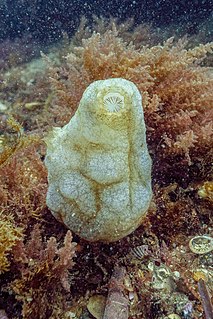
Phallusia is a genus of tunicates of the family ascidians, which includes the following species:

Phallusia nigra is a solitary marine tunicate of the ascidian class found in tropical seas around the world. It usually lives in shallow waters, attached to any hard substrate.

Ascidiella aspersa is a species of solitary sea squirts native to the northeastern Atlantic, from the Mediterranean Sea to Norway. They possess oval bodies up to 50 to 130 mm in length. Their branchial siphons are conical and positioned at the top of the body. They possess six to eight lobes. The atrial siphons are located at the upper third of the side of the body and possess six lobes. The body is covered by a firm transparent test that is greyish to brown in color. The test often snag detritus that remain loosely attached to the animal. When expanded, at most 40 tentacles can be observed on the inside surface of the branchial wall. Both the openings of the branchial and atrial siphons possess lighter colored ridges on their rims. They may also be frilled at times. A. aspersa are attached to the substrates by the left side of their bodies. They can be found in dense groups of unfused individuals on hard surfaces like rocks. at depths of up to 90 m (300 ft).
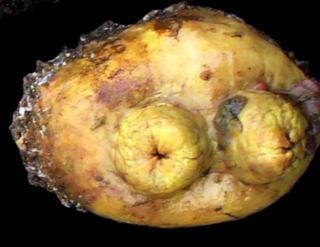
Pyura dalbyi, the yellow cunjevoi, is a species of large, solitary ascidians, or sea squirts.

Pyura herdmani, one of two southern African species of "red bait", is a sessile ascidian, or sea squirt, that lives in coastal waters attached to rocks or artificial structures. Sea squirts are named for their habit of squirting a stream of water from their exhalant siphons when touched at low tide.
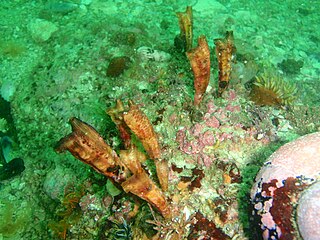
Styela angularis is a solitary, hermaphroditic ascidian tunicate that is found along the coast of Southern Africa from Lüderitz Bay in Namibia to the Eastern Cape.

Eudistoma is a genus of sea squirts belonging to the class Ascidiacea. It was first described in 1909 by Maurice Caullery. Originally it was thought to be a subgenus of Distoma. Eudistoma is the most species-rich genus in the family Polycitordae, with 124 valid species as of 2014. They are found in tropical and temperate waters; some species are also found in the Antarctic and subtropical area.
Culeolus elegans is a species of ascidian tunicates in the family Pyuridae. It is found in New Caledonia.
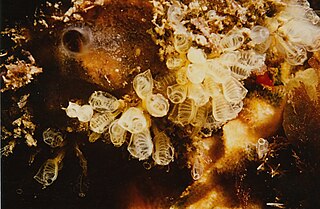
Pycnoclavella is a genus of sea squirts first circumscribed by Walter Garstang in 1891. The generic name comes from the Ancient Greek πυκνός (puknós) meaning "closely united". In 1990, Patricia Kott placed Pycnoclavella in its own family, Pycnoclavellidae, but in 2008 it was moved back to Clavelinidae.
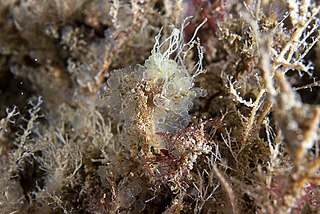
Perophora listeri is a species of colonial sea squirt in the genus Perophora, native to the North Atlantic.


















